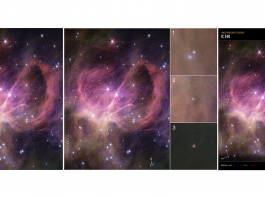An international team of researchers have found that atmospheric CO2 levels hold the key to discovering habitable planets.
The team aims to find habitable planets and potentially life itself by comparing the amount of carbon dioxide in their atmosphere to neighbouring planets.
Compared to neighbouring planets, if a planet has a reduced amount of CO2 in its atmosphere, it suggests the presence of liquid water on the surface. The researchers can infer that a drop in carbon dioxide levels is a result of being dissolved into an ocean or sequestrated by planetary biomass.
The work is published in the journal Nature Astronomy.
What is the habitable zone?
Habitable planets are capable of hosting and retaining liquid water on their surfaces. If a planet is too close to its star, it is too hot, those too far away are too cold, and those in the habitable zone are just right.
The habitable zone is sometimes referred to as the Goldilocks zone.
No current method for detecting planet habitability
Although researchers have attempted to identify planets in the theoretical habitable zones of their stars, there was previously no way to find out if they had liquid water on their surfaces.
The scientific community have made great progress in defining biosignatures – chemical tracers of biological processes, but there has been no method for detecting habitable planets until now.
Devising a new habitability signature
The team came up with a habitability signature which can be used to identify whether a planet has liquid water.
Before this, scientists attempted to identify the presence of liquid water by looking at how starlight reflects off water.
However, this signature is too weak for current observatories to detect, whereas the new habitability signature can be applied with ease.
Amaury Triaud, Professor of Exoplanetology at the University of Birmingham, who co-led the study, said: “It is fairly easy to measure the amount of carbon dioxide in a planet’s atmosphere. This is because CO2 is a strong absorber in the infrared, the same property causing the current rise in global temperatures here on Earth.
“By comparing the amount of CO2 in different planets’ atmospheres, we can use this new habitability signature to identify those planets with oceans, which make them more likely to be able to support life.
“For example, we know that initially, the Earth’s atmosphere used to be mostly CO2, but then the carbon dissolved into the ocean and made the planet able to support life for the last four billion years or so.”
Dr Julien de Wit, co-leader of the study, added: “Despite early hopes, most of our colleagues had eventually come to the conclusion that major telescopes like the JWST would not be able to detect life on exoplanets. Our work brings new hope.
“By leveraging the signature of carbon dioxide, not only can we infer the presence of liquid water on a faraway planet, but it also provides a path to identify life itself.”
Providing insights into environmental tipping points
As well as being a method to identify habitable planets, the research can also be used to gain insights into environmental tipping points.
Triaud explained: “By examining the levels of CO2 in other planets’ atmospheres, we can empirically measure habitability and compare it to our theoretical expectations. This helps gather context for the climate crisis we face on Earth to find out at which point the levels of carbon make a planet uninhabitable.
“For example, Venus and Earth look incredibly similar, but there is a very high level of carbon in Venus’ atmosphere. There may have been a past climatic tipping point that led to Venus becoming uninhabitable.”
The next steps for the team
The researchers will now detect the atmospheric carbon dioxide compositions of a range of exoplanets and identify which have oceans on their surface.
The team will prioritise further observations of potentially habitable planets.









